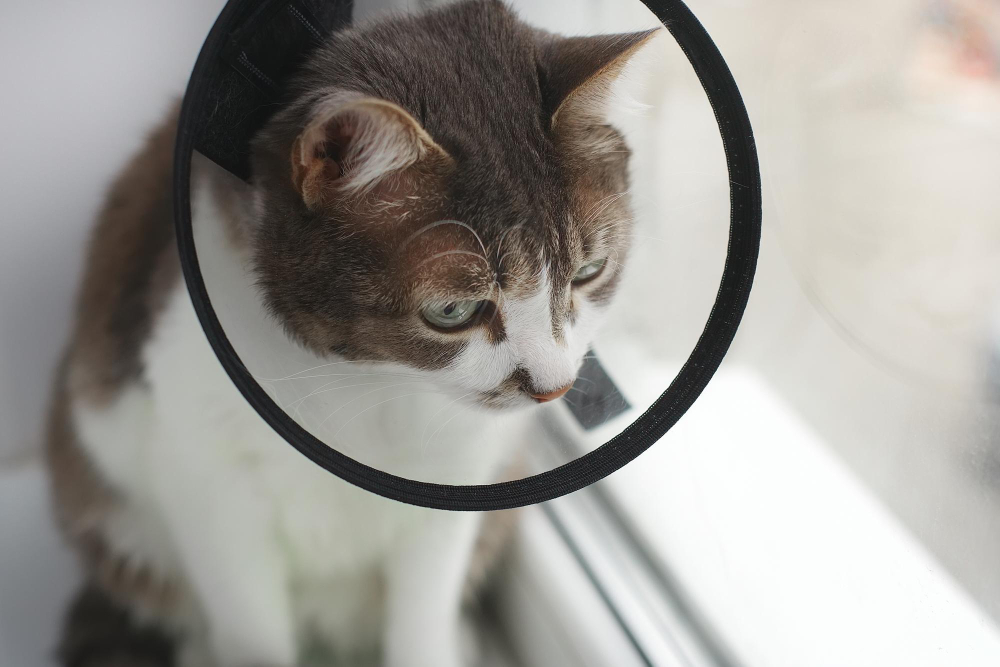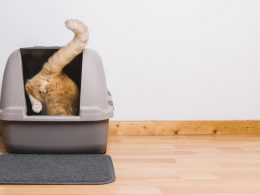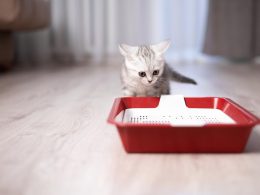Keep the cone on your cat if they are comfortable. Using a large enough litter box shouldn’t be a problem for her as long as it’s not covered. However, the cone may get in the way if the litter box is small and she wants to poke around in it to see what’s happening.
While your cat is wearing the cone of shame, he may have difficulty eating, drinking, or using the litter box. Although he should still be able to accomplish these things provided the cone is on correctly.
Eliminate any litter box coverings so he can quickly move about in the box. You can also put the box in a more open section of the house, even if it’s a little distasteful, so your pet can move around. While wearing the cone of shame may also help him relax and feel better.
Cones of shame make everything more complicated. It’s tough to do simple tasks like eating, drinking, and bathroom use. You may begin searching for alternatives to making him wear a cone. He may wear a shirt as an option. Cats can wear shirts sized for babies between the ages of 0 and 3 months. Your cat will likely be less stressed out by this method.
Why Is My Cat Acting Weird With a Cone On?
Some cats don’t mind wearing a cone, whereas others hesitate or have difficulty adjusting to their new surroundings. As a result, they perceive noises differently and have a narrower field of vision, which could be upsetting.
Your cat’s recuperation period may be impacted by stress. Therefore, a few weeks before your cat’s forthcoming surgery, ask your doctor for a cone to use for desensitization. Please take a few minutes during the day to help your cat get used to the cone and learn how to go about their routine while wearing it.
While wearing a cone, cats are more prone to getting stuck, so be sure to keep an eye on your cat’s location and block off areas where this could happen. Additionally, you may consider taking the cover off your cat’s litter box to make it easier for them to enter and exit.
Talk to your vet about whether or not your cat needs to wear a plastic cone after surgery based on their post-op behavior. For example, some cats don’t disturb their suture site, while others are more concerned about picking at the stitches. A soft fabric style cone or an inflated donut collar may be an option if your cat becomes overly anxious while wearing a regular plastic cone.
How Can I Calm My Cat Down With a Cone On?
It can improve your cat’s quality of life while wearing a cone. The best person to know your cat’s preferences for food and where they prefer to be pampered is you, the owner.
- Start by making sure the cone is the right size for your cat. A poorly-fitting cone may be the source of their discomfort. Two fingers should fit between the cone and the cat’s neck.
- Consider the size of the cone you chose for your cat before purchasing it. To prevent patients from accessing their wounds while wearing the cone, it should be neither too little nor too large.
- With their cone on, your cat should be kept away from stairwells and other potentially hazardous situations. Keep these areas off-limits for the time being to prevent children from slipping downstairs or taking other dangerous routes.
- You can do a few other things to cheer up your cat besides making the cone comfier. If you want to cheer up your cat, play to what they like and what makes them happy, which you know best.
Can a Cat Hurt Themselves With a Cone?
Cats can injure themselves when they scratch against a rigid plastic cone. While some cats can squirm out of the cone, others may become trapped in tight spaces or beneath a bed, so be on the lookout for your little cat and take precautions to prevent her from becoming trapped.
The collar, while incredibly useful, has the potential to be inconvenient and restrict movement. It keeps pets from damaging post-surgical wounds by gnawing and licking them.
Having to deal with cones is never a pleasant experience. Many cats find it difficult to even get out of bed for the first few hours after being fitted with a cone.
Others walk into walls while others go backward. Finally, some cats will only crawl or drudge over the floor, refusing to walk. Allow Kitty some time to acclimate to her new surroundings.
To deal with feline injuries, you must work with cats’ natural tendency to hide their discomfort. Consider the possibility that a cat with apparent signs of injury will be a lure for nearby predators.
Do not remove a protective collar from your pet without consulting your veterinarian first. Only remove your cat’s cone or collar if it obstructs her airway. Call your veterinarian immediately if your cat can squirm out of a collar by loosening it. Since a collar is often the only thing stopping an ill cat from worsening her wounds, vets stress this point.
How Long Does It Take a Cat To Adjust To a Cone?
Exactly how long should my cat be wearing the cone? Until the wound has healed, the collar must be worn. Depending on the type of injury, it could take a few days or weeks.
Cones can be necessary for your cat’s post-surgery recovery, although some cats loathe wearing them. Despite your cat’s best efforts to remove the cone, these suggestions should help you keep it in place.
The cone that a cat wears after a procedure like a spay or neuter is the primary cause of the cat’s inability to wear the cone for long periods. Although most vets will supply the best available cone and ensure that it is appropriate for your cat, there are exceptions.
A minority of people may offer a cone that’s completely inappropriate. The situation is compounded if you purchase the cone from a third party. Using a cone from another cat’s surgery can also be quite common.
Cats may become accustomed to their cones if you put them on and take them off for an hour at a time. Put the cone back on if your cat begins to notice the stitches when the cone is removed.














